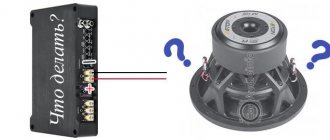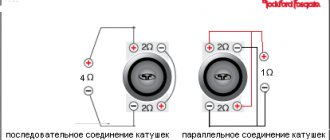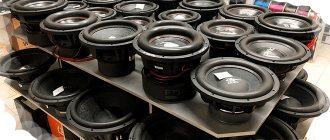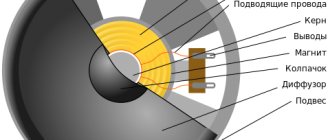Switching circuits for one subwoofer to an amplifier
In this section we have collected all possible subwoofer options and variations of their connection.
Speaker with two coils 4+4 Ohm
How can I connect it?
- Using a series circuit in 8 ohms.
- Using a 2 ohm parallel circuit.
Speaker with two coils 2+2 Ohm
How can I connect it?
- Using a 4 ohm series circuit.
- Using a 1 ohm parallel circuit.
Speaker with two coils 1+1 Ohm
How can I connect it?
- Using a 2 ohm series circuit.
- Using a 0.5 ohm parallel circuit.
Parallel connection of speakers
The picture on the left shows two speakers connected in parallel. We feed the plus from the amplifier to the positive input of speaker A, the minus to the minus of speaker B. Next, we connect the positive output of speaker B to plus A, minus A to minus B. The circuit seems to be clear.
What about resistance? What will be the resulting resistance of two speakers connected in parallel? If two identical speakers are connected in parallel, then the total resistance of such a connection will be half as much. That is, we divide the actual resistance of the column by two.
How to connect two speakers to one channel in parallel
The figure shows the resistance of both horns at 2 ohms. The total for a parallel connection will be 1 ohm. That is, it turns out that when speakers are connected in parallel, the output signal power is higher than when one is connected. The use of such a low-impedance load is possible when connected to a subwoofer.
Parallel connection of three or more speakers per channel
The principle of connecting three or more speakers in parallel to one channel is the same. Plus from the output of the amplifier we feed it to all connected speakers. Minus - for all the minuses.
Connecting three or more speakers per channel in parallel
As a result, it turns out that the same signal arrives at each of the circuit elements. And the current is divided into “rivulets”, that is, it becomes smaller. And the current that flows through the speaker depends on the resistance of this element.
Parallel power
To calculate the power that will go from the amplifier to the channel with a parallel connection, the same. Po = Pr * Zr/Zt. But the quotient Zr/Zt will be greater. After all, as mentioned earlier, the total resistance when connecting speakers in parallel decreases. As in the example above - when connecting two 4 Ohm speakers in parallel, the resulting resistance will be 2 Ohms. If we substitute the data from the previously considered example (for a serial connection) into the formula, we find that with an amplifier power of 100 W, 100 W * 4 Ohms / 2 Ohms will go into the channel = 100 W * 2 = 200 W. That is, 200 W will be consumed per channel. But the amplifier must operate with a low-impedance load.
How to connect 2 speakers to one channel is one of the options.
This property can be used if you have a low-power amplifier, but want a loud sound. But we need speakers that can handle high power. This is actually not a problem. There are options rated for hundreds of watts. They just cost accordingly.
The ability of the amplifier to operate with low loads is also important. So here pay attention to such a parameter as the minimum load. And, again, it is better that the load is slightly higher than the minimum. Operating at the limit of performance always results in accelerated failure.
There are options rated for hundreds of watts. Pay attention to such a parameter as the minimum load. And, again, it is better that the load is slightly higher than the minimum. Operating at the limit of performance always results in accelerated failure.
As already said, you should avoid working at the limit. This applies to both speakers and amplifier. Nowadays you can select equipment to suit almost any requirement.
Switching diagrams for two subwoofers to an amplifier
In this section we have collected “almost” all possible options for connecting two subwoofers
Two speakers with two coils 4+4 Ohm
How can they be connected?
- Using a 4 ohm series circuit.
- Using a 1 ohm parallel circuit.
Two speakers with two coils 2+2 Ohm
How can they be connected?
- Using a 2 ohm series circuit.
- Using a 0.5 ohm parallel circuit.
Two speakers with two coils 1+1 Ohm
How can they be connected?
- Using a 1 ohm series circuit.
- Using a 0.25 ohm parallel circuit.
Daisy chaining of speakers
A daisy chain connection is when they are switched on one after the other, like carriages. If you look at the diagram, the wires are connected like this. We feed the minus from the output of the amplifier to the minus of speakers A, and the plus to the plus of loudspeaker B. And we connect their free inputs (plus at A and minus at B) to each other.
Connecting speakers in series: resistance adds up, output power drops
Please note that the impedance of the speaker chain increases. It is summed up from all components. In the example, two 2 Ohm speakers are connected in series. The total resistance is already 4 Ohms. This connection is good if the amplifier cannot operate with a low-impedance load. Low resistance is 2 ohms and below. In this case, either speakers with a higher resistance are connected, or low-impedance ones are connected in series.
How to connect three or more speakers in series
How to connect three speakers in series to one channel? Yes, everything is the same - one by one. Minus, apply to minus first (A); plus - to the plus of the third C (or last). We connect the free plus from element A to the minus of element B. Then we feed plus B to minus C. So we get a chain of three speakers connected to one channel.
How to connect 3 speakers to 1 channel in series
If you need to connect four or more fragments in series to one channel, simply insert them in the middle. Don't forget that circuit resistance adds up. With each new element in the chain it becomes larger.
Power in series connection
As the resistance increases, the output power will drop. How many watts will each speaker receive when connected in series? And you can count. There is a formula - it is in the picture.
Input power is the power that the amplifier will put into the channel, that is, what we are trying to calculate. The measured power is that indicated in the characteristics (what goes into the channel according to the passport data). And Zr is the resistance at which the power was measured. It is usually written in the characteristics as the minimum load on the channel. And the total resistance is the resistance of the speakers that you plan to “hang” on this channel.
Formula for calculating the actual power supplied to the amplifier channel
Let's apply the formula with an example. Let us have a 2-channel amplifier that outputs 100 W (2*100 W) to each channel. It cannot work with low-resistance loads (2 Ohms and below). Therefore, it was decided to connect two speakers with a resistance of 2 Ohms in series for each channel. We substitute the data into the formula: 100 W * (4 Ohm / 8 Ohm) = 100 W * 0.5 = 50 W. This is what will go into each channel.
The power of the speakers must be selected so that it is 10-20% higher than the power that will be received by it. In this case, any loudspeaker will work for a long time. And if you take the power “back to back”, then even the highest quality speaker will very soon wheeze and will need to be replaced .
Since there will be two loudspeakers on the channel with the same parameters, the channel power will be divided in half. So we get that each speaker will receive 25 watts. If you add the desired power reserve, you will have to look for speakers with a power of at least 30-35 W.











